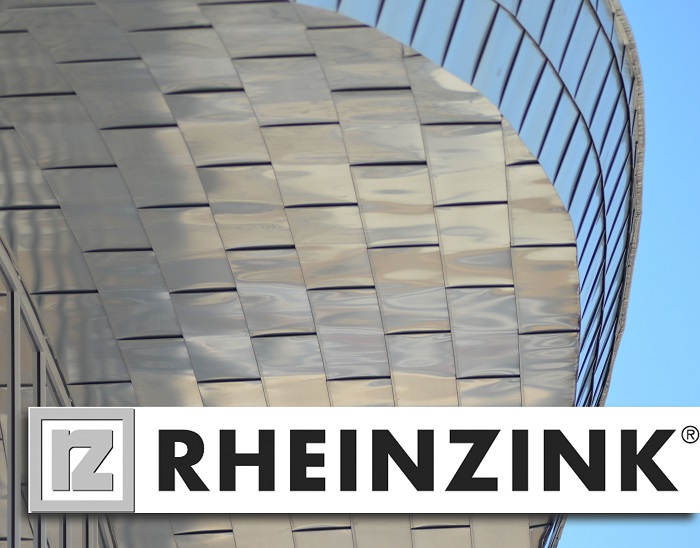Made to last for generations – maintenance-free – durable – sustainable, Zinc has been used for roofing for over 150 years. For decades it has been the preferred choice for roofs all over the world in the form of RHEINZINK. This natural material has traced a prestigious course for almost half a century. It wins over customers with its high quality and is bound to impress with its timeless styling.
Roof coverings made of RHEINZINK set benchmarks, guaranteeing functionality and aesthetic appeal for years to come. They are completely maintenance-free and protect the basic fabric of buildings while still looking attractive. Their comprehensive roof drainage range will help you give perfect expression to your ideas.
Double Standing Seam
As regards the material zinc, the double standing seam is seen as a further development of the original hollow seam or the simple standing seam. First mentioned in the relevant literature in 1899, it is the preferred choice over other systems for roof pitches below 25°. The minimum pitch here is 3° (approx 5.2%). The term “double standing seam” characterizes one of the classic longitudinal joint types used for panels installed next to each other forming a rain proof layer. For international markets it is the 25mm high double standing seam that has established itself as a market leader.
The profile is folded and closed manually or mechanically using hand formers or seam closing tapered panel machines. Special shapes such as convex and concave curves or tapers can be produced without any problem. Traditional architecture or modern design will be enhanced by the elegant lines of the double standing seam thanks to its wide range of details.
Angled Standing Seam
The angled standing seam is a relatively new development in the field of a traditional sheet metal technology: it was not mentioned in technical literature until the beginning of the 20th century. It is Ideal for roofs with a pitch of min 25°. Closing the seams of the prefabricated sections is simple, compared with the double standing seam. Trays can easily expand and surface distortions are avoided as less stress is placed on the metal when the seam is formed.
The angled standing seam is a popular choice in visible areas of metal roofing where the roof pitch is steeper, e.g parapets, fascias and mansard roofs, whether running in the traditional vertical direction, diagonally or horizontally. The angled seam a more visible seam width then the double standing seam and are an eye-catching feature even over large areas of roofing.
Click Roll Cap
The roll cap system is considered as the most traditional metal covering technique still in use today. With the RHEINZINK Click Roll Cap system, panels and caps can be produced ex works up to a length of 6m in a single process. For longer sections mobile roll formers are available for hire.
The RHEINZINK click roll cap is also available in the standard length 3m. The system is suitable for roof pitches of min 3°. When subject to higher wind loading, structured underlays or weather/rain-proof membranes are essential.
The click roll cap fastener made of 1.0 mm thick galvanized steel, replaces the traditional wooden rolls clips and continuous cleats: the fastener also functions as the fixing profile for the panels and preformed cappings. At the eave end the roll cap splays out to allow the individual caps to overlap slightly. In conjunction with the factory pre-finished ridge and eaves termination, on site assembly has been significantly rationalised with the RHEINZINK click roll fastener.
Tiles
The group of RHEINZINK small-format tiles is made up of square and diamond tiles. Unlike shingles which look similar, these tiles have return folds on the top and bottom edges in the form of a single lock joint. They can be produced either manually or mechanically and offer reliable yet appealing solutions even for complex shape thanks to their small format. Virtually all curves can be catered for without any problem. The classic applications of these small tiles also include covering, domes, dormers, chimney stacks and roof edges.
The size of RHEINZINK flat lock tiles makes them suitable for large areas of roofing. These tiles offer designers tremendous scope for structuring buildings as they can be installed vertically, horizontally or diagonally in a range of widths. Variable joint staggering also opens up a wealth of options for designers. Complex structures with convex and concave geometries are easily feasible with this roof system.
Corrugated sheeting system
Corrugated roofing became widely used in many countries from the 1840s after its invention by Henry Palmer, a British architect and engineer and a key component of attractive architecture from the Victorian era, particularly in many Commonwealth states, and other countries. Over the decades, technology has enhanced the desirable properties of corrugated roofing. It has entrenched it as a durable roofing choice in industry, agriculture and, again increasingly, in the residential sector.
These technological advances have led to a perfect, long-lasting, maintenance-free solution for every design in an innovative contemporary building material: RHEINZINK – an alloy consisting of 99.995 % high purity zinc and precisely defined amounts of copper and titanium and which requires little energy in production.


Contracted a Rheinzink approved installer. Their first reaction was to recommend an alternative , cheaper zinc. Please note Rheinzink only guarantee their material so you have no warranty re is all Atomon i]even with an approved installer. I was very unhappy with timing of the installation and general finish. Rheinzink were called but generally supported the installer. No other Rheinzink installer was willing to prepare an independent report. We settled but did not use them to complete a capping around the edge of the building. Water pools everywhere in the gutters and there are many shortcomings in both finish and performance. We have multiple leaks and will have to bear the costs of rectification of a circa £100,000 project. Neither Rheinzink or the installer will accept any responsibility.